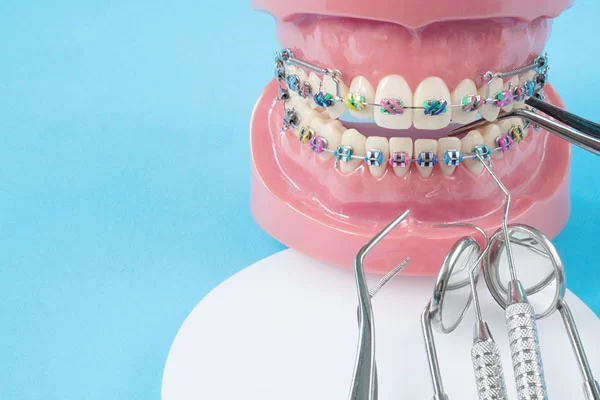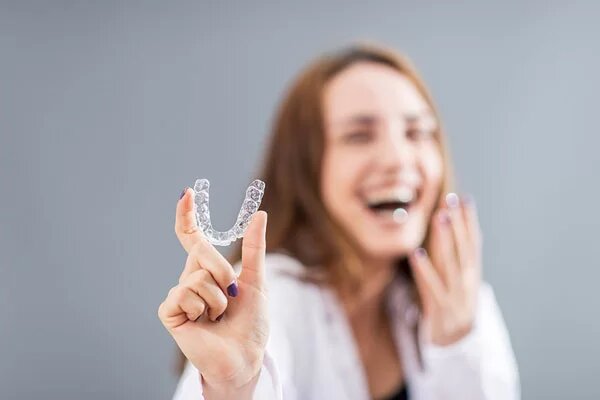Invisalign® vs. Braces: Which Orthodontic Treatment is Right for You?
If you’re considering orthodontic treatment to improve your smile, you may be wondering which option is right for you. Both Invisalign® and braces are effective ways to straighten teeth and correct bite issues, but they each have their own unique advantages and disadvantages.
Our Holyoke, MA, dentist’s goal is to provide you with the information you need to make an informed decision about your orthodontic care. We break down Invisalign vs. braces below.
How Invisalign Works
Invisalign is a modern alternative to traditional braces, using clear, removable aligners to gradually shift teeth into place. Your Invisalign provider or orthodontist creates a custom treatment plan using 3D images of your teeth, and a series of aligners are produced. Patients wear each set of aligners for one to two weeks, making slight adjustments to tooth position, and only remove them to eat, drink, brush, and floss. Regular check-ups ensure the treatment is progressing as planned, with the entire process averaging 12 to 18 months.
Once completed, retainers may be required to maintain the new teeth’ positions.
How Metal Braces Work
Metal braces work by applying consistent pressure to your teeth over an extended period, which gradually moves them into the desired position. This pressure also stimulates the jawbone to remodel itself, accommodating the new positions of the teeth. The main components of braces are brackets attached to each tooth and an archwire that connects these brackets. When the orthodontist adjusts the tension in the archwire, this initiates the teeth’s movement. Regular adjustments over months to years gradually realign the teeth and correct the bite.
Your braces treatment will also vary depending on the type of braces recommended. Your orthodontist may recommend metal braces, lingual braces, or ceramic braces.
Invisalign vs Braces: A Comparison
Appearance
- Invisalign: As the name suggests, Invisalign aligners are nearly invisible. They consist of clear plastic trays that fit over the teeth, making them a more discreet option. Most of the time, no one will even notice you’re going through Invisalign treatment.
- Braces: Traditional metal braces consist of brackets that are adhered to your teeth and connected by a wire. They’re highly noticeable and may make some feel self-conscious during treatment. Some braces may also require other components, such as rubber bands.
Costs
- Invisalign: Generally, Invisalign tends to be more expensive than traditional braces. Patients can expect to spend between $3,000 to $8,000 depending on factors such as geographical location, dental insurance coverage, and the complexity of their alignment issues.
- Traditional Braces: Traditional metal braces are typically less expensive than Invisalign, but the cost can vary based on the complexity of the treatment and geographical location. On average, braces cost between $3,000 to $7,000.
Treatment Time
- Invisalign: Invisalign treatments typically last between 12 to 18 months, but they can vary depending on the complexity of the case.
- Braces: Traditional braces often need to be worn for about 24 months, although this can also vary. If you have severely crooked teeth or severely misaligned teeth, your treatment can take longer.
Comfort
- Invisalign: Invisalign aligners are made of smooth plastic, making them more comfortable than braces. They can also be removed, allowing for relief if discomfort arises.
- Braces: Braces are fixed onto the teeth and can cause irritation to the inside of the mouth. The adjustment process can also create discomfort.
Maintenance
- Invisalign: Clear aligners should be cleaned regularly and taken out while eating or drinking anything other than water.
- Braces: Braces require careful cleaning around the brackets and wires. Certain foods that can damage or get stuck in braces must be avoided.
Versatility
- Invisalign: Invisalign is great for correcting various orthodontic issues, but complex cases may still require braces.
- Braces: Braces are extremely versatile and can correct many complex orthodontic problems.
Check-Ups
- Invisalign: You’ll need to see your orthodontist every four to six weeks, and you’ll switch to a new set of aligners every one to two weeks.
- Braces: You’ll typically see your orthodontist for a tightening every four to six weeks.
Frequently Asked Questions
Yes, Invisalign is generally considered to be less painful than traditional metal braces. The reason for this is that Invisalign uses a series of smooth plastic aligners that are custom-made to fit your teeth, reducing the likelihood of irritation and soreness.
Although there may still be some discomfort when switching to a new set of aligners every few weeks, it is often milder compared to the pain and soreness experienced with adjustments for braces.
In many cases, it’s possible to switch from traditional braces to Invisalign trays, but it’s not a decision that should be taken lightly. Before making the switch, your orthodontist will need to assess your specific dental needs and the progress of your current treatment. If your orthodontic issues are compatible with Invisalign and you haven’t made significant progress with braces, switching might be an option.
Yes, it’s important to wear a retainer after any orthodontic treatment to prevent your teeth from shifting back to their original position. Your dentist will likely recommend wearing a retainer for several months or even years after Invisalign treatment. The length of time will depend on your specific case and the extent of the orthodontic correction needed.
Invisalign typically causes less discomfort compared to traditional braces. Traditional braces, with their metal brackets and wires, can cause sores inside the mouth and be uncomfortable when tightened.
On the other hand, Invisalign aligners are made from smooth plastic, reducing the likelihood of mouth irritation. However, both options can cause some discomfort, especially when teeth are initially moving or when new aligners are introduced in the case of Invisalign.
Take the First Step Towards Your Dream Smile
Are you tired of feeling self-conscious about your smile? Do you want to improve your oral health and boost your confidence? Don’t wait any longer — take action today! Contact our Holyoke dentist today at (413) 538-7400 to schedule a consultation and learn more about the orthodontic treatment options available to you.
When it comes to Invisalign vs. braces, the best choice is what will help you achieve a perfect smile and pristine oral health. We serve patients in the Greater Springfield area, including Westfield, Southampton, South Hadley, and nearby Western Massachusetts communities.


